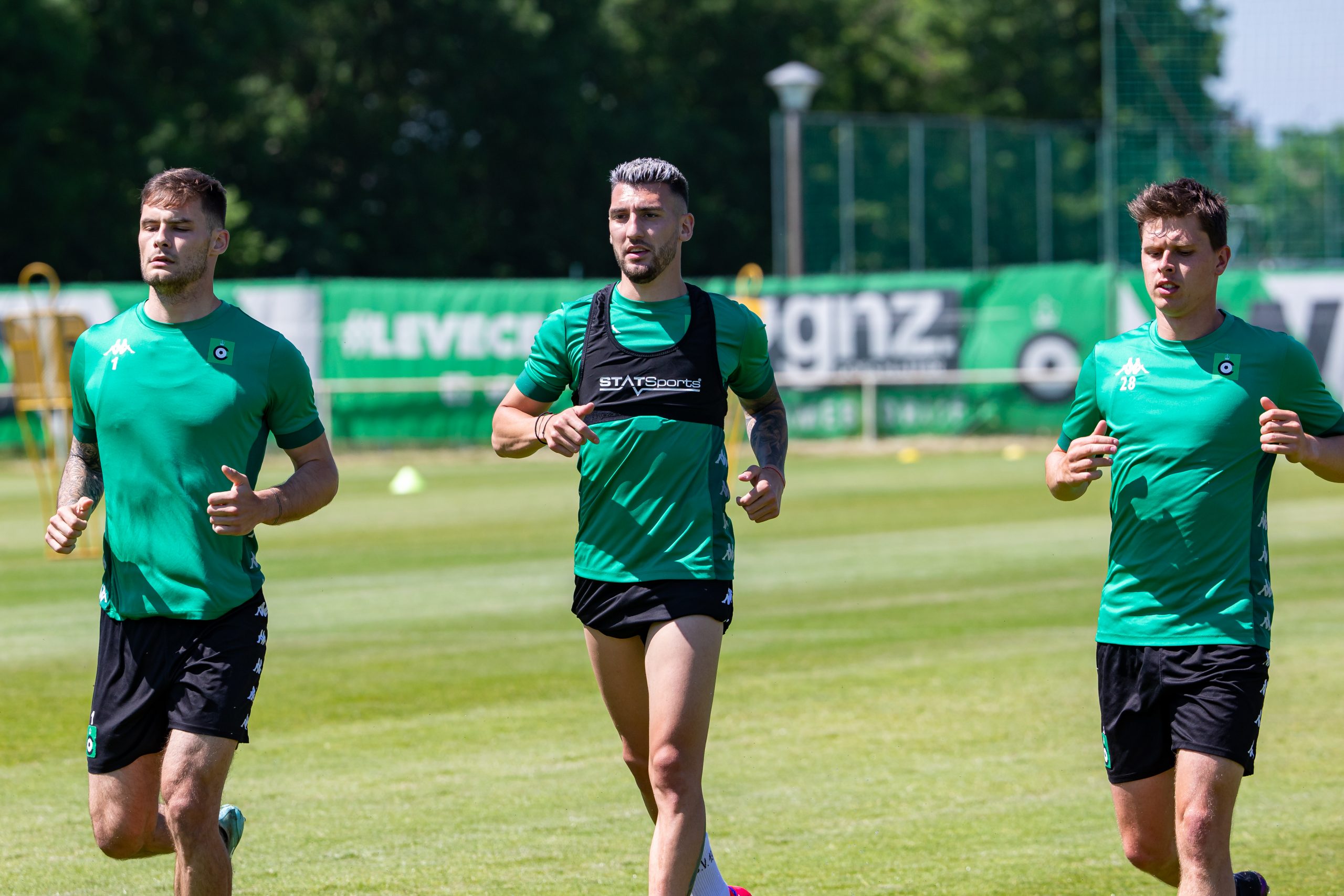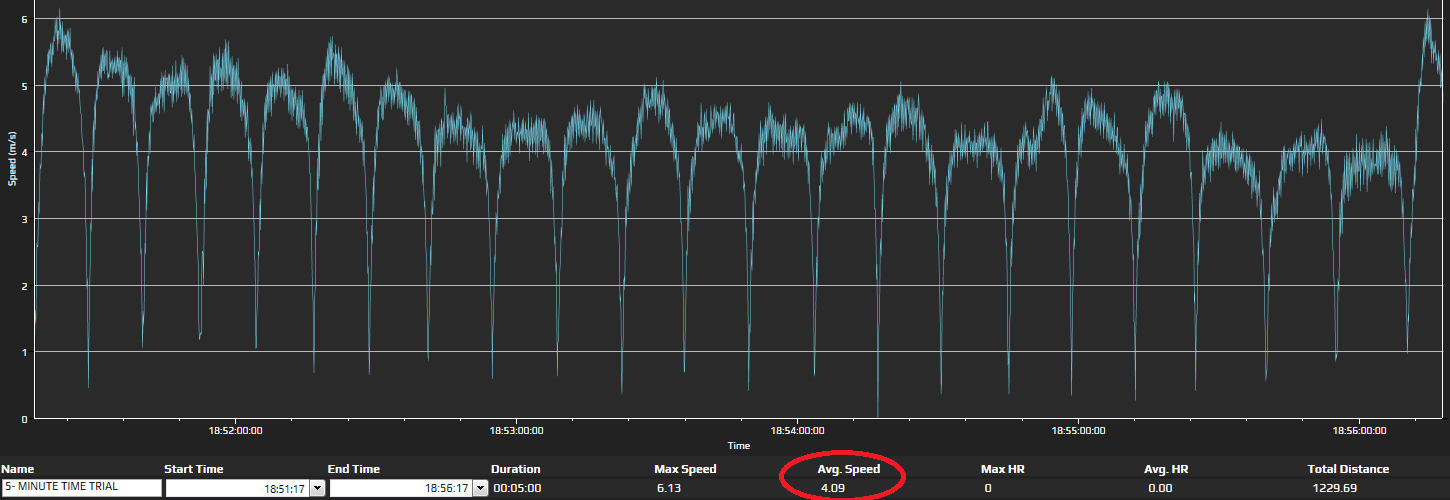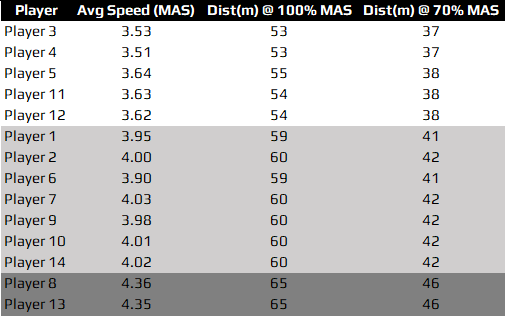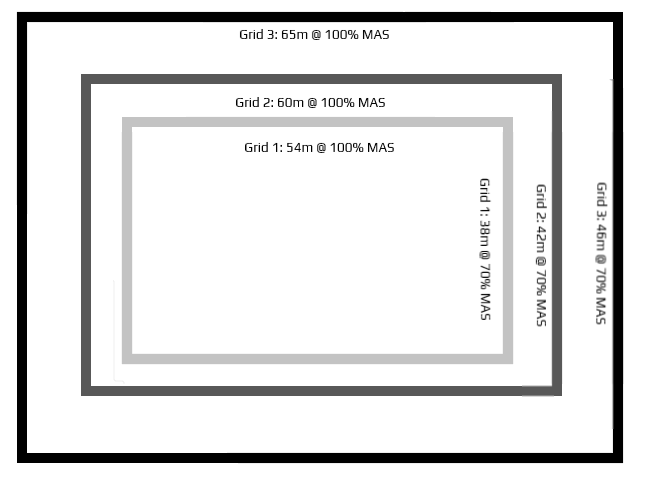
20 Mar Maximal Aerobic Speed: A Useful Tool To Improve Aerobic Capacity?
Introduction
Developing aerobic capacity is an important aspect of many field sports and has been identified as an influential factor in soccer performance, particularly in parameters such as distance covered, work intensity (average heart rate), number of sprints and ball touches during game play [1].
An increase in aerobic fitness can improve recovery time between the high intensity bursts within a soccer match, thus having a positive effect on repeated sprint ability [2].
Aerobic conditioning can be performed using a number of methods. Previously Long Slow Distance (LSD) (low intensity for 20 – 40 minutes) was a common method of aerobic conditioning, however, recently there has been a shift towards high intensity interval training working at Maximal Aerobic Speed (MAS).
MAS can be simply defined as the lowest running velocity at which maximal oxygen uptake occurs (vVO2Max) and was devised as a means to assess the aerobic capacities and requirements of running performance [3]. Research suggests that MAS can be used as an important tool for conditioning aerobic capacities in athletes could act as a more efficient method than an LSD approach.
This article will highlight how the use of STATSports technology practitioners to measure an individual athlete’s MAS score and therefore use results to devise drills which further develop aerobic capacities.
Testing Procedure
Ideally when testing athletes, coaches are looking for the most efficient methods while attaining accurate and valuable results that give an idea of where the athlete stands can be ultimately acted on to improve physical performance.
There are numerous ways in which MAS can be tested within a group of athletes. It has been shown that set distance time trials have a strong correlation achieving MAS scores within field sport athletes [4]. Also, the use of a set time trial has been validated as a means to achieve MAS.
A 5-minute time trial has been found to be an appropriate method of evaluating MAS which previously has shown a strong correlation with laboratory V02Max testing [5]. The idea of this test is for athletes to elicit maximal aerobic contribution with reduced anaerobic input. Therefore, it is important for athletes to be encouraged to ‘pace’ themselves during the test to attain accurate results.
The aim is for the athlete to achieve as much distance as possible within the 5 minutes, with MAS scores being simply calculated by using the average speed over this time (Figure 1).

Figure 1. Drill editor displaying individual MAS Score as Average Speed.
Potentially this test could be performed twice within a week if using this method for the first as a method to familiarise athletes with the velocity required to achieve best results.
Fourteen youth soccer players wore STATSports Apex devices while completing a 5-minute time trial with the aim to run as much distance as they could in this time limit. Using Sonra Live streaming on the iPad application the players were added to a drill where they were monitored live. After 5 minutes the drill was stopped, and the created drills were sent back to Sonra Desktop. Each players unit was downloaded, and live drills were applied on the download screen.
| Figure 3. MAS Grids for 3 different groups depending on MAS score. |
Individual MAS scores are displayed below the activity graph in the Drill Editor section within the 5-minute Time Trial Drill as the average speed (Figure 1). Users can also export MAS scores as an Excel export by including the average speed metric for the 5-minute Time Trial drill in the Excel Report.
Practical Applications

Figure 2. Average Speed for each player in the 5-minute Time Trial as the MAS score. Distance required at 100% MAS & 70% MAS for MAS Grids.
Individual based testing allows coaches to prescribe individualized training sessions and drills to optimally overload their athletes to enhance performance and progression.
Generalized training of athletes with different fitness levels can lead to certain players not reaching sufficient overload to adapt to the specific training stimulus and/ or some athletes training at a higher intensity than the required intensity of the stimulus leading to overtraining [6].
Using these results, it is possible for coaches to devise drills to build aerobic capacity. MAS is used widely through many different methods and models. A simple method of aerobic conditioning using MAS are MAS Grids, it is a basic yet effective way to condition large groups of athletes at once who may have varying levels of aerobic fitness.
Studies have shown that a working intensity of 100% – 120% MAS is the critical factor supporting improvements in aerobic power and this method is becoming more prominent in elite and lower level field sport athletes [7]. MAS Grids support this research using interval 100% MAS running for 15s:15s active recovery (70% MAS). It takes 1 minute for a full grid to be completed (2 runs at MAS & 2 runs @70% MAS), and it should be carried out for 5 minutes with no static rest (5 laps). 2-4 sets should be carried out with 2-3 minutes of rest between sets [7].

Figure 3. MAS Grids for 3 different groups depending on MAS score.
Distances at 100% MAS are calculated as MAS (m/s) x 15(s), this will provide the distance for each individual athlete should cover at 100% MAS in 15 seconds. Recovery distances are calculated as 70% MAS(m/s) x 15(s), this will be the active recovery distance and athletes will have to reach the specific distance in 15 seconds.
Athletes can be split into groups depending on level of aerobic fitness and MAS score. In this scenario 3 groups have been devised, however, more or less groups can be used depending on number of athletes and variety of fitness levels.
It may be necessary to retest MAS after 3/4 weeks to monitor aerobic improvements and potentially progress athletes. Athletes can move up a level of grid to ensure that they are reaching sufficient overload to improve aerobic capacity [7].
Practical Considerations
When choosing a testing protocol to influence training prescription, it is important that sport scientists and coaches consider the desired training style, sporting application and logistics of the testing procedure [6]. The testing method in this case was chosen based on the athletes training age and aerobic fitness levels.
MAS Grids alone are not considered sport specific training drills but may add to sporting performance as a physical conditioning method. Further physical, technical or tactical qualities should not be neglected. Therefore, integration of Small Sided Games with MAS Grids in periodized training can help develop these qualities and other components of the sport with induced fatigue (skill performance & decision making) [7].
References
- Helgerud, J., Engen, L. C., Wisløff, U., & Hoff, J. (2001). Aerobic endurance training improves soccer performance. Medicine & Science in Sports & Exercise, 33(11), 1925 – 1931.
- Da Silva, J. F., Guglielmo, L. G., & Bishop, D. (2010). Relationship between different measures of aerobic fitness and repeated-sprint ability in elite soccer players. The Journal of Strength & Conditioning Research, 24(8), 2115 – 2121.
- Billat, L. V., & Koralsztein, J. P. (1996). Significance of the velocity at VO 2max and time to exhaustion at this velocity. Sports Medicine, 22(2), 90 – 108.
- Bellenger, C. R., Fuller, J. T., Nelson, M. J., Hartland, M., Buckley, J. D., & Debenedictis, T. A. (2015). Predicting maximal aerobic speed through set distance time-trials. European journal of applied physiology, 115(12), 2593 – 2598.
- Berthon, P., Fellmann, N., Bedu, M., Beaune, B., Dabonneville, M., Coudert, J., & Chamoux, A. (1997). A 5-min running field test as a measurement of maximal aerobic velocity. European journal of applied physiology and occupational physiology, 75(3), 233 – 238.
- Clarke, R., Dobson, A., & Hughes, J. (2016). Metabolic Conditioning: Field Tests to Determine a Training Velocity. Strength & Conditioning Journal, 38(1), 38 – 47.
- Baker, D. (2011). Recent trends in high-intensity aerobic training for field sports. Prof Strength Cond, 22, 3 – 8.
Author Details
Jack Traynor
Sport Scientist l Sport Science Dept.